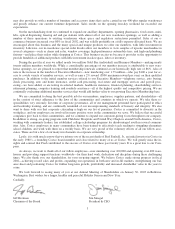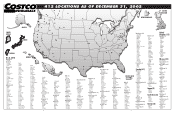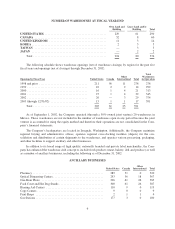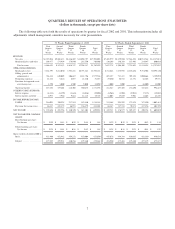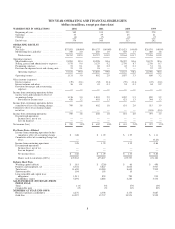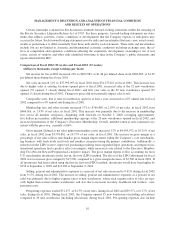Costco 2002 Annual Report Download - page 13
Download and view the complete annual report
Please find page 13 of the 2002 Costco annual report below. You can navigate through the pages in the report by either clicking on the pages listed below, or by using the keyword search tool below to find specific information within the annual report.beginning with renewals on October 1, 2000. Additionally, membership sign-ups at the 32 new warehouses
opened in fiscal 2001 were also a factor in this increase.
Gross margin (defined as net sales minus merchandise costs) increased 7% to $3,538,881, or 10.37% of net
sales, in fiscal 2001 from $3,298,553, or 10.43% of net sales, in fiscal 2000. Gross margin as a percentage of net
sales decreased by six basis points due to costs related to the Executive Membership two percent reward pro-
gram, which was somewhat offset by gross margin improvement in the Company’s core merchandising activities
and ancillary operations. The gross margin figures reflect accounting for most U.S. merchandise inventories on
the last-in, first-out (LIFO) method. If all inventories had been valued using the first-in, first-out (FIFO) method,
inventories would have been higher by $13,650 at September 2, 2001, and $8,150 at September 3, 2000.
Selling, general and administrative expenses as a percent of net sales increased to 9.17% during fiscal 2001
from 8.71% during fiscal 2000, due to a number of a factors, including an increase in the entry level wage rate of
hourly employees beginning in the fourth quarter of fiscal 2000; continued expansion of the Company’s co-
branded credit card program; higher utility and energy costs; and higher expenses associated with an increase in
new warehouse openings year-over-year (a net of 32 and 21 warehouses opened in fiscal 2001 and 2000, re-
spectively) where expense ratios to sales are typically higher than in more mature warehouses.
Preopening expenses totaled $59,571, or 0.17% of net sales, during fiscal 2001 and $42,321, or 0.13% of net
sales, during fiscal 2000. During fiscal 2001, the Company opened 39 new warehouses (including relocations)
compared to 25 new warehouses (including relocations) during fiscal 2000. Pre-opening expenses also include
costs related to remodels and expanded ancillary operations at existing warehouses, as well as expanded interna-
tional operations.
The provision for impaired assets and closing costs was $18,000 in fiscal 2001 compared to $7,000 in fiscal
2000. The fiscal 2001 provision includes charges of $19,000 for the Canadian administrative reorganization (See
“Item 7—Management’s Discussion and Analysis of Financial Condition and Results of Operations”—Liquidity
and Capital Resources), $15,231 for the impairment of long-lived assets and $2,412 for warehouse closing ex-
pense, which were offset by $18,643 of gains on the sale of real property. At September 2, 2001, the reserve for
warehouse closing costs was $15,434, of which $6,538 related to future lease obligations. This compares to a re-
serve for warehouse closing costs of $11,762 at September 3, 2000, of which $8,887 related to future lease
obligations. (See Part II, “Item 8—Financial Statements”—Notes to Consolidated Financial Statements—
Note 1).
Interest expense totaled $32,024 in fiscal 2001, and $39,281 in fiscal 2000. The decrease in interest expense
is primarily due to an increase in capitalized interest related to construction projects and a decrease related to the
retirement of an unsecured note payable to banks with a principal amount totaling $140,000 in April 2001.
Interest income and other totaled $43,238 in fiscal 2001 compared to $54,226 in fiscal 2000. The decrease
was primarily due to lower rates of interest earned on lower balances of cash and cash equivalents and short-term
investments during fiscal 2001 as compared to fiscal 2000, which was partially offset by improved earnings from
Costco Mexico (a 50% owned joint venture) on a year-over-year basis.
The effective income tax rate on earnings was 40% in both fiscal 2001 and fiscal 2000.
Liquidity and Capital Resources (dollars in thousands)
Expansion Plans
Costco’s primary requirement for capital is the financing of the land, building and equipment costs for new
warehouses plus the costs of initial warehouse operations and working capital requirements, as well as additional
capital for international expansion through investments in foreign subsidiaries and joint ventures.
While there can be no assurance that current expectations will be realized, and plans are subject to change
upon further review, it is management’s current intention to spend an aggregate of approximately $1,000,000 to
$1,100,000 during fiscal 2003 in the United States and Canada for real estate, construction, remodeling and
12




